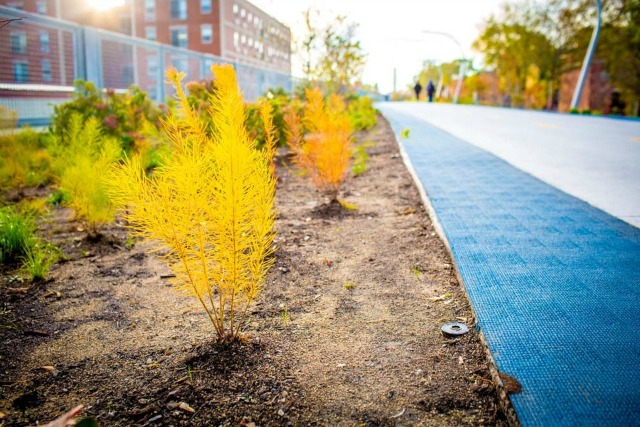The 606 Is Bike Mag's Favorite Path In The World, But Its Legacy Is Complex
By Stephen Gossett in News on May 30, 2017 7:33PM

The 606. Photo by Braden Nesin/Chicagoist
Chicago's increasingly heavily trafficked Bloomingdale Trail (a.k.a. The 606) feels less like a novelty and more like an established cornerstone of the alternative-transportation map. But that doesn't mean it's not something special. In fact, the Trail just got its most effusive national shine yet, when Bicycling Magazine dubbed it one of the best of its kind in the world—although it failed to examine some the broader housing and socioeconomic implications brought forth by the trail.
"I have explored hundreds of paths around the world, but this one is my favorite," author Devi Lockwood wrote, praising the rail-to-trail conversion that opened in 2015. Indeed, Bicycle was even more fulsome, originally publishing the article with the headline "Chicago's Bloomingdale Trail Is the World's Best Bike Path."
The Trail and the 606 network are indeed beautiful and practical additions to Chicago's green landscape and transit network. There's no doubt. Lockwood enumerates the positives well:
"The Bloomingdale Trail can be considered one of the most innovative trails in the country, if not the world. It’s successful at being so many different things for so many people: a public art gallery, a garden, a bike-commuting artery, a running track, a place where kids can play away from the dangers of traffic. Four Chicago neighborhoods (Bucktown, Wicker Park, Logan Square, and Humboldt Park) previously without adequate access to outdoor space now have proximity to one of the best."
And that doesn't even include crime-reduction aspects for areas near the Trail that research has found.
But the article also fails to account for the gentrification battles and very-real housing cost surges that have rolled along the Bloomingdale Trail, as well. No, Bicycle Magazine is not Next City or Citylab, and one could argue that's not its beat. But the omission makes it even clearer that one aspect of urban planning can't be really be considered in isolation from the other—especially as we seem to have reached something of a tipping point.
Last week, aldermen introduced an ordinance that would dramatically increase fees for de-conversion and demolition fees for properties around The 606, in order to preserve existing housing stock, according to the Sun-Times. (That one of the aldermen sponsoring the proposal, Ald. Roberto Maldonado (Ward 26) made bank on those skyrocketed property values, as reported by DNA Info, merely adds to the complicated tangle that is The 606.) And frustrations about gentrification and displacement are already taking root in Pilsen and Little Village as the similar rail-to-trail project the Paseo advances.
That said, we agree with Bicycle Magazine, just as we agreed with them when they crowned Chicago the most bike-friendly city in the country. It is a spectacular amenity, one we shouldn't take for granted. But acknowledging its complexities doesn't diminish what makes it great.